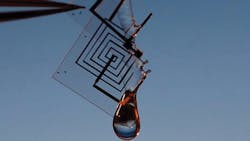MORSECORP joins DARPA program for melting air-drop unmanned aircraft
ARLINGTON, Va. - U.S. military researchers have chosen a third company to develop small, unpowered, and unmanned aircraft to air-drop small packages for forward-deployed forces. After delivery, the unmanned aircraft melt without any detectable trace to keep them out of enemy hands.
Officials of the U.S. Defense Advanced Research Projects Agency (DARPA) in Arlington, Va., have added MORSECORP Inc. in Cambridge, Mass., to the Inbound, Controlled, Air-Releasable, Unrecoverable Systems (ICARUS) program.
MORSECORP joins the Xerox Palo Alto Research Center (PARC) in Palo Alto, Calif., and DZYNE Technologies Inc. in Fairfax, Va., on the ICARUS program, which seeks to design and demonstrate a precision, autonomous, guided, air-delivery vehicle that vanishes on command.
MORSECORP specializes in vehicle guidance, navigation, and control; mission planning; multi-vehicle autonomy; computer vision; and mobile computing.
The ICARUS approach is similar to the DARPA Vanishing Programmable Resources (VAPR) program to develop sensitive electronic components able to self-destruct on command to keep them out of the hands of potential adversaries. PARC also is involved in the VAPR program.
ICARUS is asking MORSECORP, PARC, and DZYNE to develop a vanishing unmanned aerial vehicle (UAV) able to deliver a small package no larger than three pounds to a GPS-programmed location with 33-foot accuracy.
The small aircraft, which the companies will develop to operate at night, must be able to vanish within four hours of landing, leaving remnants no larger than 100 microns - or about the width of a human hair.
The vanishing vehicles that MORSECORP, PARC, and DZYNE will develop must be no larger than 10 feet in their largest dimension, and be able to glide for nearly 100 miles when released from altitudes of 35,000 feet.
DARPA researchers primarily want to determine whether a large structure can be made transient cheaply enough to be disposable, such that they limit the logistics trail and make the most of range.
Critical technical challenges facing the ICARUS program cover two major categories: aerodynamics and materials.
The ICARUS program will span two phases and 26 months, culminating in a field-test of vanishing precision air delivery prototypes.
MORSECORP, PARC, and DZYNE are involved in the first phase, which will develop and demonstrate an air delivery vehicle using nontransient materials. The optional second phase will fabricate a field testable, vanishing air delivery vehicle.
FOR MORE INFORMATION visit MORSECORP online at www.morse-corp.com, PARC at www.parc.com, DZYNE Technologies at www.dzynetech.com, or DARPA at www.darpa.mil.

